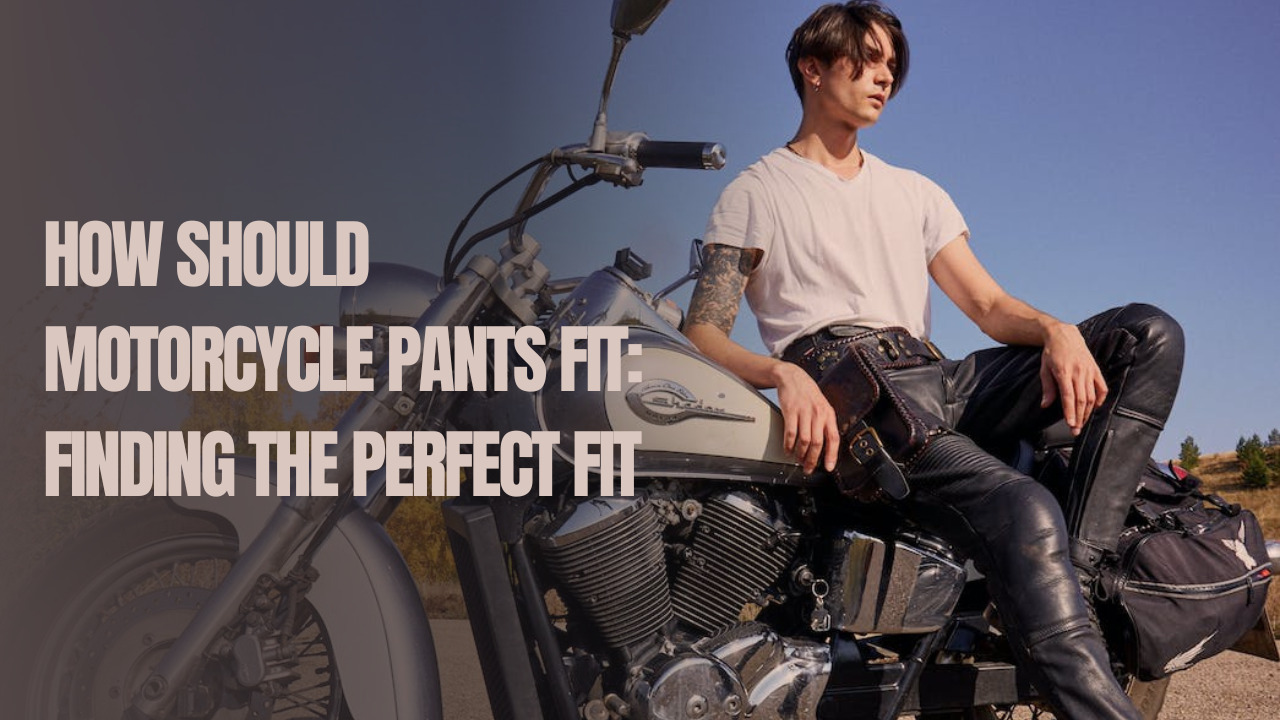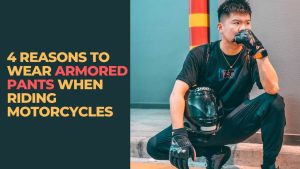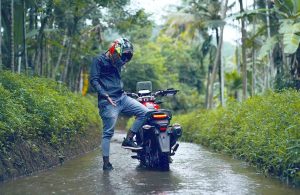Finding motorcycle pants that fit just right isn’t always easy. But taking the time to get the perfect fit could save your hide. Proper fit means your moto pants move with you, keeping armor in place to protect your most vulnerable spots. Loose pants flap dangerously; too tight and you’ll be bunched up and miserable.
We’ll walk through the key factors to dial in a fit that’s safe and comfy. Read on to learn the insider tips for how should motorcycle pants fit from top to bottom.
Leather vs Textiles: Choosing Your Riding Pants
You’ve got two main material options for motorcycle pants: leather or textile. Both offer protection, but they’ve got key differences in durability, comfort, and style.
Leather pants are the gold standard if you want maximum abrasion resistance. Nothing beats a good leather for standing up to slides across the asphalt. They are also extremely durable, so they’ll last you many seasons of riding if cared for properly.
Just know that leather comes at a price – your wallet will feel the hit, and you’ll be feeling the heat. Leather pants don’t breathe well, so they’re a hot weather choice. Unless you go for a custom pair, your style options in leather are limited too.
For more flexibility, textile motorcycle pants open up a wider range of choices. Riding jeans give you everyday style with reinforcements like Kevlar and armor. They’re comfortable for cruising around town, but the lighter materials can’t handle high speeds like a track day.
Prefer better airflow? Mesh pants will keep you cool in hot climates. Large mesh panels promote serious ventilation, though mesh is not as abrasion-resistant as other textiles.
SEE MORE: Beat the Rain: The Best Waterproof Motorcycle Jeans to Keep You Dry
When you need maximum protection and weatherproofing, look for full textile pants. These rugged textiles can handle slides nearly as well as leather. You’ll also get features like waterproof membranes and thermal liners to extend your riding season. Full textiles are the practical choice for long distances and variable conditions.
So consider whether you need ultimate abrasion protection or the flexibility of technical textiles. Your riding style and local weather should help determine the best material for your motorcycle pants.
How Should Motorcycle Pants Fit: Dialing In Your Measurements
Getting the right fit starts with your measurements. Motorcycle pants size differently than regular pants, so grab a measuring tape to get your exact specs.
Length
For length, stand tall and measure your inseam from crotch to ankle. The pants should hit just a touch longer than your inseam standing up. This prevents them from pulling up and exposing your ankle when you ride.
When getting fitted for moto pants, allow for a little extra length in the leg. Motorcycle pants should hit slightly below your ankle bone when standing tall. This prevents the “highwater” look when you hop on your hog.
As you roll, bending your knees will pull the pant legs up your calf. The extra length keeps them from turning into capris. Stop worrying about exposed ankles and focus on the road ahead.
Also consider how the length impacts your armor. Knee pads will ride up as your legs flex, so longer pants allow them to stay centered on your actual knees. Armor that creeps won’t protect your joints when you need it most.
Resist the urge to trim the hem or roll up cuffs to show off your stylish boots. Doing so defeats the protective purpose of moto pants. Let them bunch around your ankles while riding so the armor stays put.
You can always get a more precise fit with custom leathers or alterations. But for ready-to-wear textile pants, go long for safety on the road. Slightly bunchy beats too short any day.
SEE MORE: 5 Best Leather Motorcycle Boots You Can Buy in 2023
Waist and Hips
Cruiser riders can often wear pants with a waist size close to their street clothes. The upright seated position keeps their torso and hips more vertical. Sport bike riders need extra room when tucked into an aggressive riding position. Measure your natural waist, then size up if you ride a crotcher rocket.
Riding jeans and casual pants come in standard waist sizes measured in inches or centimeters. Technical pants use alpha sizing like Small, Medium, Large to accommodate layering and adjustability.
Consider adding belt loops, an adjustable waist, or suspenders to dial in the fit. A little extra room with the ability to cinch provides flexibility as you move around on the bike.
The goal is no pinching or restriction as you ride. When sizing up for comfort, ensure hip and knee armor stays in place. A little extra space is fine as long as the pants don’t flap dangerously at speed.
Leg Fit
When it comes to leg fit, motorcycle pants come in two main styles: straight/skinny or loose/baggy. Which you choose impacts both safety and comfort.
Straight or skinny motorcycle pants sit closer to your body, avoiding excess material that could flap at speed. This helps keep armor right where it should be as you ride – no shifting around. The skinny style also cuts down on wind resistance for less drag.
Just be sure straight fitting moto pants aren’t overly restrictive. You’ll still want good flexibility to work the controls and shift your weight on the bike. Knee armor that’s too tight can limit your mobility just as much as pants that are too loose.
Speaking of loose, go easy on the baggy pants. Excess material risks getting caught on components or blowing around to distract you. Pants billowing in the breeze also allow knee pads to move out of place instead of protecting your joints.
The ideal leg fit balances a streamlined shape with flexibility. Seek motorcycle pants that are snug without squeezing and shaped to let your armor do its job. With the right straight leg fit, you can focus on the road ahead.
Rider Comfort
A proper fitting motorcycle pant prioritizes rider comfort. Key features to look for include stretch panels, ventilation, moisture wicking fabrics and insulation.
Stretch materials provide flexibility for natural movement on the bike. Panels placed at knees, hips and the crotch allow you to shift positions without restriction. Stretch also prevents pants from binding as you transition from standing to seated.
Ventilation zones, mesh panels and zippered vents help air flow to prevent overheating. Perforated leather or textile combined with inner brief liners keep you cooler too.
Moisture wicking fabric pulls sweat away from your skin for dry comfort on hot days. Thermal linings and insulation locks in warmth when riding in colder climates.
Avoid pants that are too baggy or too tight. You want a close fit that lets your joints move freely. The goal is keeping comfortable through changing ride conditions.
Dialed in fit means no distractions from ill-fitting moto pants. Focus on the road and ride in total comfort.
SEE MORE: What Factors Contribute to Increased Risk of Motorcycle Accidents?
Armor Up: Choosing the Right Impact Protection
When it comes to motorcycle pants, protection is just as crucial as fit. Focus your search on pants that include knee and hip armor.
Quality armor covers the knee and hip joints completely as you ride. It should remain centered over the joints without shifting out of place as you move. Pants with too much length or excess material can allow armor to slide downward when riding.
Look for flexible, low-profile armor that molds to your body in motion. Materials like D3O provide serious impact protection that doesn’t restrict your range of motion. Stiff, bulky pads limit mobility and comfort.
Knee and hip pads should absorb shock without protruding or pressing on the joints. If the armor pokes, binds or chafes, it’s time to size up or try a different brand.
The right armor becomes an extension of your body. You’ll forget it’s there until the moment it helps save your hide. Don’t ride without this essential impact protection.
FAQs About How Should Motorcycle Pants Fit
Should motorcycle pants be tight or loose?
The best fit is snug without restricting movement. Pants that are too loose can flap around dangerously at speed. Too tight and armor may not stay put or you’ll be uncomfortable.
Do motorcycle pants run big or small?
Motorcycle pants often run differently than regular pants. Refer to each brand’s specific sizing chart for the best fit. Measure your body and don’t assume standard jean sizes.
What’s the difference between men’s and women’s motorcycle pants?
Women’s motorcycle pants have a contoured shape with room in the hips and rear. Men’s pants accommodate larger waists and thighs. Choose the gender fit aligned with your body type.
Should I order motorcycle pants a size up?
If between sizes, it’s generally better to size up for comfort and flexibility. But first check the brand’s fit guidance and your measurements against their sizing chart.
What do motorcycle pants numbers like 32/30 mean?
The first number is the waist size in inches. The second number is the inseam length, also in inches. Measure yourself to find your sizes.




